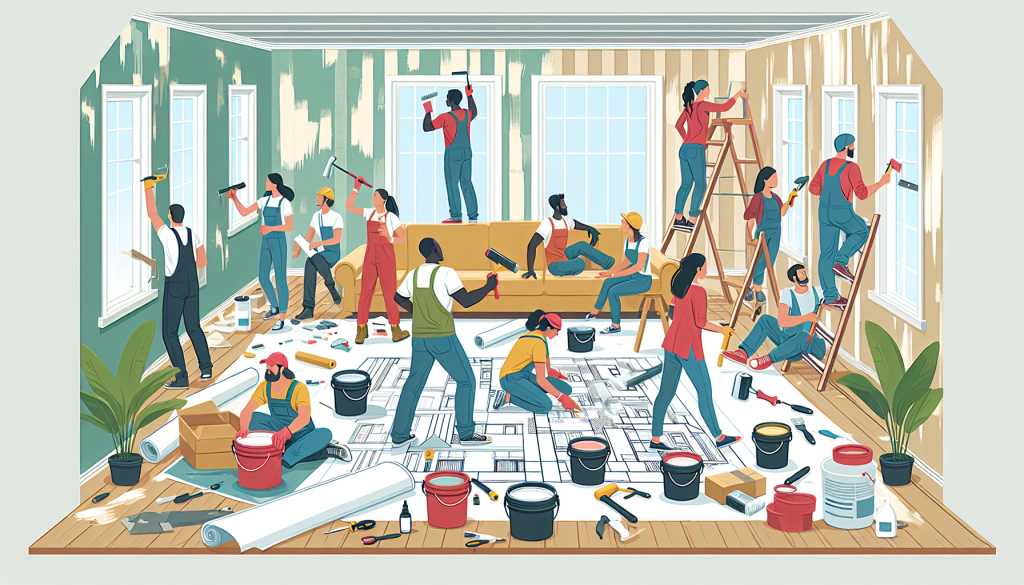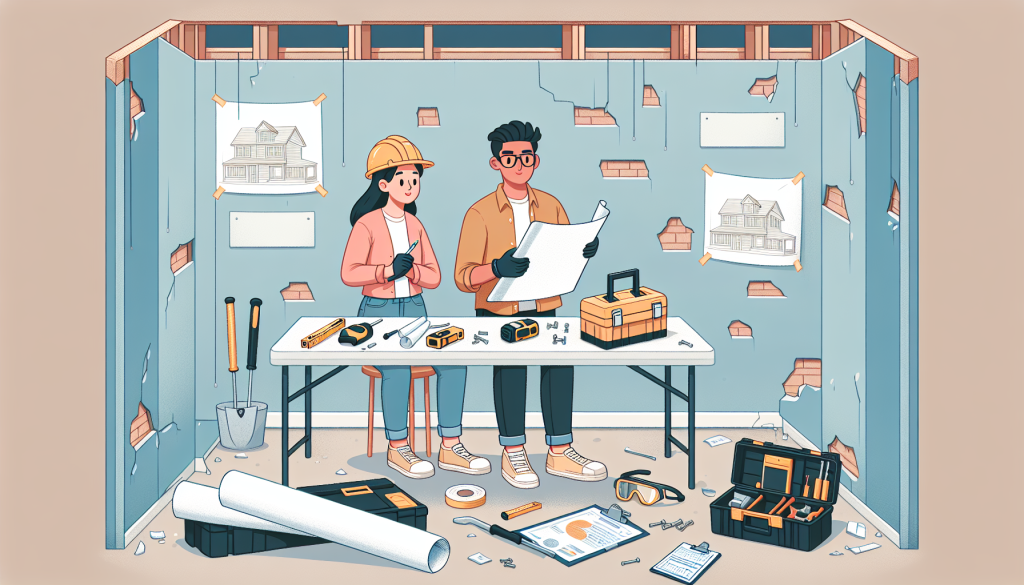Are you considering taking on a DIY home renovation project? If so, there are several key considerations you should keep in mind to ensure a successful and enjoyable experience. From setting a realistic budget to carefully planning the timeline and gathering all necessary permits, this article will guide you through the essential steps for a smooth and rewarding DIY home renovation. So, grab your tools and get ready to transform your space with confidence!
Table of Contents
ToggleBudgeting
Determining your budget
When embarking on a DIY home renovation project, the first step is to determine your budget. Assess your current financial situation and set aside an amount that you are comfortable spending on the project. It is essential to be realistic and account for both the expected and unexpected expenses that may arise during the renovation process. By setting a clear budget, you can avoid overspending and ensure that your project stays on track.
Researching costs
Once you have established your budget, it is time to research the costs associated with your renovation project. Take into consideration the materials, labor, and any additional expenses that may be required. Conduct thorough research to understand the average prices for the materials you need, as well as any labor costs if you plan to hire professionals. This will give you an idea of what to expect and help you allocate your funds accordingly.
Allocating funds
After determining your budget and researching costs, it is crucial to allocate your funds appropriately. Divide your budget into different categories, such as materials, labor, permits, and unexpected expenses. By allocating funds to each category, you can ensure that you have enough resources to cover all aspects of your renovation project. Remember to leave some extra room in your budget for unforeseen expenses that may arise during the process. Properly allocating your funds will help keep your project financially stable and prevent any unnecessary delays.
Identifying Project Scope
Assessing the needs and goals
Before diving into a DIY home renovation, it is essential to assess the needs and goals of your project. Determine what specific aspects of your home you want to renovate and why. Are you looking to improve functionality, enhance aesthetics, or increase the value of your property? By clearly identifying your needs and objectives, you can prioritize tasks and streamline your renovation process.
Creating a prioritized list
Once you have determined your needs and goals, create a prioritized list of tasks. Start by focusing on the most critical areas that require attention. For example, if your bathroom needs repairs, prioritize fixing plumbing issues over cosmetic changes. By prioritizing tasks, you can tackle the most essential elements of your renovation project first and gradually move on to less critical aspects.
Considering future needs
When planning a DIY home renovation, it is crucial to consider future needs. Think about how the renovation will impact your lifestyle in the long term and whether it meets your future requirements. For example, if you are renovating a nursery, consider designing it in a way that can easily be converted into a child’s bedroom as they grow. By considering future needs, you can save time and money by incorporating elements that will remain relevant even as your needs evolve.
Building Permits and Regulations
Understanding local regulations
Before commencing any home renovation project, it is vital to understand the local regulations governing construction and renovation. Research the specific codes and permits required in your area by contacting your local building authority. Familiarizing yourself with these regulations will help you avoid legal complications during the renovation process and ensure that your project meets all safety and quality standards.
Checking if permits are required
Based on your research, determine whether permits are required for your specific renovation project. Permits may be necessary for structural changes, electrical work, plumbing modifications, and even cosmetic alterations, depending on the scope of your project. It is crucial to check which permits are required and obtain them before starting any work. Failing to obtain the necessary permits can result in fines or even the halting of your project.
Obtaining necessary permits
If permits are indeed required for your renovation project, it is essential to obtain them before commencing work. Contact your local building authority and provide them with the necessary documentation and plans for review. Be prepared to pay any applicable fees and allow sufficient time for the permit approval process. Once you have obtained the required permits, you can proceed with your renovation project with confidence, knowing that you are in compliance with local regulations.
Safety Precautions
Identifying potential hazards
Safety should be a top priority when undertaking a DIY home renovation project. Before starting any work, thoroughly inspect your property for potential hazards. Look for issues such as faulty wiring, mold, asbestos, or structural weaknesses. Identifying potential hazards will help you take appropriate precautions and ensure the safety of yourself and your family throughout the renovation process.
Using appropriate protective gear
When working on a DIY renovation project, it is crucial to use appropriate protective gear to minimize the risk of accidents and injuries. Depending on the tasks involved, this may include safety goggles, gloves, a hard hat, masks, or ear protectors. Always prioritize your safety and follow recommended safety guidelines for each specific task you undertake.
Hiring professionals for complex tasks
While you may be capable of tackling many DIY home renovation tasks, some jobs may require the expertise of professionals. For complex tasks such as electrical work, plumbing, or structural modifications, it is advisable to hire licensed and experienced contractors. Not only will professionals ensure that the job is done correctly and safely, but they can also help you navigate any potential challenges that may arise during the project.
Understanding Skill Level
Assessing your own skills
Before taking on a DIY home renovation project, honestly assess your own skills and capabilities. Be realistic about what you can handle and what may be beyond your expertise. Consider your past experience with similar projects and the complexity of the tasks involved in your renovation. Assessing your skills will help you determine which tasks you can confidently complete on your own and which tasks may require professional assistance.
Considering the complexity of tasks
Each DIY home renovation project has a range of tasks with varying levels of complexity. Consider the complexity of the tasks involved and determine whether they align with your skill level. For example, some tasks, such as painting walls or installing new light fixtures, may be relatively straightforward for most individuals. However, tasks like installing a new electrical panel or remodeling a kitchen may require more advanced skills. By carefully considering the complexity of tasks, you can plan accordingly and ensure the success of your renovation project.
Learning new skills, if necessary
If you identify gaps in your skills that are crucial for your DIY home renovation project, consider learning new skills. There are numerous resources available, such as online tutorials, workshops, and books, that can help you acquire the knowledge and expertise necessary for specific tasks. Learning new skills not only expands your capabilities but also gives you a sense of accomplishment as you take on previously unfamiliar projects.
Time Management
Creating a realistic timeline
Time management plays a significant role in the success of any DIY home renovation project. Create a realistic timeline by breaking down your project into smaller tasks and estimating the time required for each. Be mindful of any external factors, such as work or family commitments, that may impact your availability. A detailed and realistic timeline will help you stay organized and ensure that you complete your project within the desired timeframe.
Accounting for unexpected delays
It’s important to anticipate and account for unexpected delays when planning your DIY home renovation. Unforeseen issues, such as discovering hidden damage or unforeseen complications, can arise during the renovation process. Factor in some extra time in your timeline to accommodate such delays and prevent undue stress. By accounting for unexpected delays, you can ensure a smoother and less rushed renovation experience.
Scheduling tasks accordingly
Once you have created a timeline and considered potential delays, it’s time to schedule your tasks accordingly. Prioritize and schedule tasks based on their dependencies, ensuring that you complete tasks in an organized manner that maximizes efficiency. For example, if you plan to paint a room, schedule it before installing new flooring to avoid any potential damage. By scheduling tasks thoughtfully, you can maintain a steady progression throughout your DIY home renovation project.
Gathering Tools and Materials
Making a comprehensive list
Before starting your DIY home renovation project, make a comprehensive list of all the tools and materials you will need. Go through each task and identify the specific tools required, ensuring that you have everything on hand before beginning the project. This will prevent unnecessary delays or frustrations when you realize you don’t have the necessary tools during the renovation process.
Researching the necessary tools
For each task, take the time to research and understand the necessary tools. Ensure that you have the right tools for the job and that they are in good working condition. If you don’t already own certain tools, consider whether it’s more cost-effective to purchase or rent them. Quality tools can make a significant difference in the outcome of your renovation project, so invest in tools that are suited to your specific needs.
Comparing prices and quality
When gathering tools and materials for your DIY home renovation, it is worth investing time in comparing prices and quality. Research different suppliers and retailers to find the best deals without compromising on quality. Pay attention to customer reviews and recommendations to ensure that you are choosing reliable products that will withstand the demands of your renovation project. By comparing prices and quality, you can make informed decisions and get the most value for your budget.
Assembling a Team
Determining if you need assistance
While DIY home renovation implies doing it yourself, it doesn’t mean you have to do it entirely alone. Determine whether you need assistance based on the complexity or scale of your project. Be honest with yourself about your limitations and consider seeking help, especially for tasks that require specialized skills or physical strength. It’s better to ask for assistance when needed than to risk compromising the quality or safety of your renovation project.
Enlisting the help of friends or family
If you decide to assemble a team for your DIY home renovation, consider enlisting the help of friends or family members. Reach out to individuals who may have relevant skills or experience and would be willing to assist you. Not only does working together make the project more enjoyable, but it can also speed up the process and ensure that tasks are completed efficiently. Just make sure to clearly communicate your expectations and express gratitude for their support.
Considering professional help
In certain instances, professional help may be necessary for your DIY home renovation project. If you are dealing with complex structural changes, electrical or plumbing work, or if you lack the necessary skills for a particular task, hiring professionals may be the best course of action. Licensed contractors or tradespeople can bring expertise and efficiency to your project, delivering high-quality results that meet safety standards. Considering professional help ensures that your renovation project is completed successfully, even if it means a slightly higher budget.
Design and Aesthetics
Planning the overall look and style
Design and aesthetics are essential aspects of any DIY home renovation. Take the time to plan and visualize the overall look and style you want to achieve before diving into the project. Consider factors such as the existing architecture, your personal preferences, and any design trends you find appealing. Look for inspiration in magazines, websites, and even visiting showrooms to help refine your vision and create a cohesive design plan.
Selecting colors and materials
Choosing colors and materials is a critical step in the design process. Select colors that align with your overall vision and create the desired atmosphere in each room. Consider factors such as natural light, furniture, and existing elements when making color choices. Similarly, research different materials and select those that fit your aesthetic preferences, durability requirements, and budget. Take samples, compare textures, and visualize how different materials will contribute to the overall design.
Creating a cohesive design plan
Once you have chosen colors and materials, it is essential to create a cohesive design plan. Ensure that the selected elements work harmoniously together and create a unified look throughout your home. Consider how different rooms will flow into one another and how the design choices will enhance the functionality and aesthetics of each space. By creating a cohesive design plan, you can achieve a visually appealing and harmonious result that reflects your personal style.
Environmental Considerations
Choosing eco-friendly materials
In today’s world, it is vital to consider the impact of our choices on the environment. When planning your DIY home renovation, opt for eco-friendly materials whenever possible. Choose sustainable materials such as bamboo flooring, low VOC (volatile organic compounds) paints, or recycled materials for countertops. By choosing eco-friendly options, you can reduce your carbon footprint and create a healthier environment within your home.
Minimizing waste and energy consumption
During your DIY home renovation, make an effort to minimize waste and energy consumption. Recycle materials whenever possible and dispose of waste responsibly. Opt for energy-efficient appliances and lighting fixtures to reduce your energy consumption and lower utility bills. Incorporate insulation and other energy-saving techniques to create a more sustainable and energy-efficient home.
Considering long-term sustainability
As you plan your DIY home renovation, consider the concept of long-term sustainability. Look beyond immediate trends and consider the longevity of your design choices. Invest in durable materials and timeless design elements that will stand the test of time. By considering long-term sustainability, you can avoid the need for frequent renovations and contribute to the overall sustainability of your home.
In conclusion, DIY home renovation planning requires careful consideration and preparation. By following these key considerations, such as budgeting, identifying project scope, understanding regulations, prioritizing safety, assessing skill levels, managing time, gathering tools and materials, assembling a team, considering design and aesthetics, and incorporating environmental considerations, you can ensure a successful and rewarding renovation experience. Remember, taking on a DIY home renovation project is an exciting opportunity to bring your vision to life, save costs, and take pride in transforming your living space.








